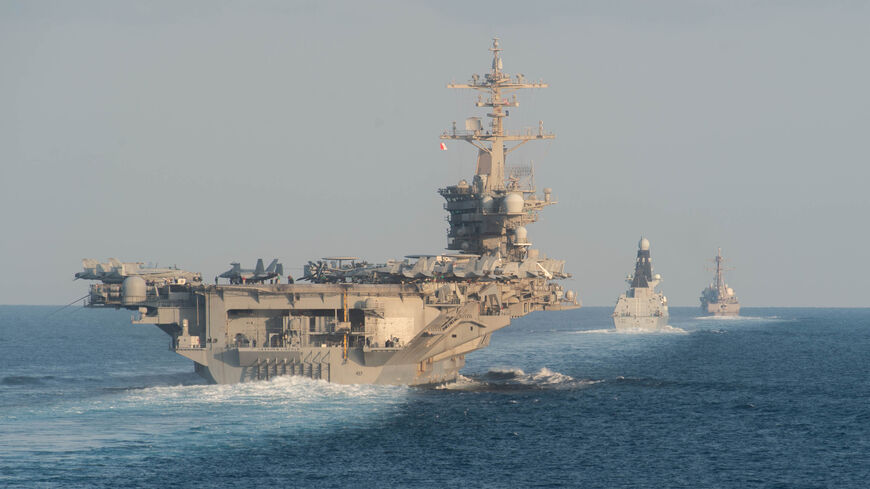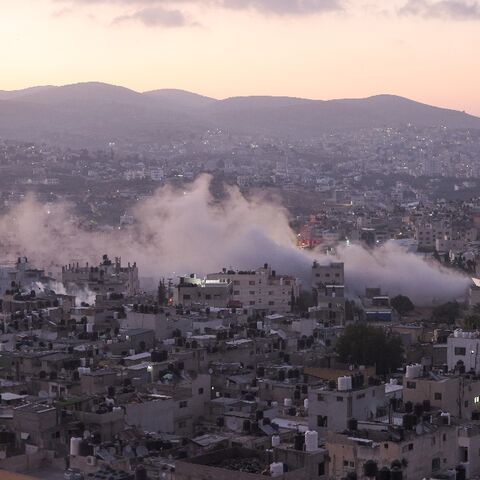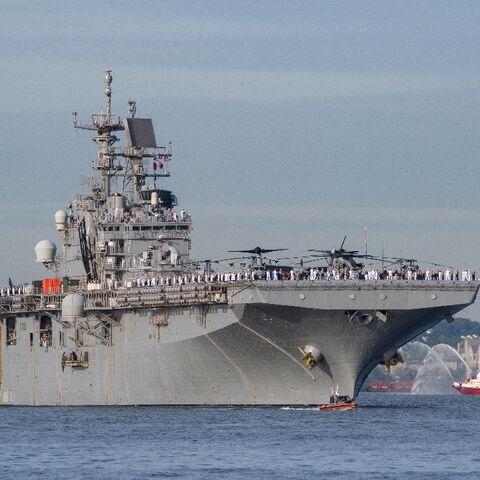WASHINGTON — A contingent of more than 3,000 US Navy personnel and Marines sailed into the Suez Canal on Sunday as the Biden administration weighs options to deter Iran from seizing commercial tanker ships in the Persian Gulf region.
The 26th Marine Expeditionary Unit, along with sailors and Marines of an Amphibious Ready Group led by the USS Bataan and accompanied by the dock landing ship USS Carter Hall, will provide “greater flexibility and maritime capability” to the United States' Bahrain-based 5th Fleet, the Navy announced today.
What that means: The Pentagon has remained mum on specifically how it intends to employ the Marines, but their arrival is part of a wider buildup of US forces in the region which defense officials described as a response to Iran’s renewed attempts to seize commercial tankers.
The deployment brings additional aircraft, helicopters and amphibious landing craft to join a dozen US F-35s, as well as F-16 and A-10 aircraft and Navy guided-missile destroyers that have already arrived in the region in recent weeks and months to ramp up joint patrols in and around the Strait of Hormuz.
Iran has escalated its attempts to seize commercial ships in Gulf waterways in recent months following the US Justice Department’s confiscation of a Marshall Islands-flagged tanker, the Suez Rajan, carrying Iranian fuel to China in April. An Iranian navy vessel opened fire on a Chevron-chartered tanker in international waters off the coast of Oman last month after the civilian ship refused orders to stop.
Iran’s navy and Islamic Revolutionary Guard Corps have harassed or seized control of at least 20 commercial shipping tankers in the region over the past two years, according to the US 5th Fleet’s numbers.
Iran’s moves have further driven a wedge into the United States’ strategic ties with Gulf states, as Saudi Arabia and the United Arab Emirates look to reduce their dependency on Washington for defense.
“It’s drawn Gulf states closer to Iran,” one American official told Al-Monitor last week. “It sends a signal to regional partners that in the absence of US forces, the US is not serious about security.”
Al-Monitor reported last week that senior Defense Department officials have been putting the finishing touches on requests for wider legal authorities from the White House to enable the military to intervene more directly to prevent Iran’s seizures of commercial tankers.
Among the military’s proposals is authorization to embark the Marines on civilian commercial ships flying foreign flags. The plan, drafted by US Central Command, first requires the consent of regional governments and private companies.
If fully approved by the Biden administration, the proposal could leverage the military’s own self-defense authorities to enable US naval and air forces to protect third-party tanker ships from acts of aggression by Iran, Al-Monitor’s sources said.
Show of force: Regardless of how the Biden administration decides, the announced deployment of an amphibious-borne Marine Expeditionary Group marks an unsubtle warning to Tehran.
“An amphibious assault ship can carry more than two dozen rotary-wing and fixed-wing aircraft, including MV-22 Osprey tilt-rotor aircraft and AV-8B Harrier attack jets in addition to several amphibious landing craft,” the Navy’s 5th Fleet said in a press release on Monday.
“A dock landing ship also supports operations for various rotary-wing aircraft, tactical vehicles and amphibious landing craft,” it read.
Marine Expeditionary Units specialize in amphibious landings and “visit, board, search and seizure” (VBSS) operations — or taking control of vessels, typically in cases of smuggling or piracy — among other tasks.
“The ARG/MEU can be used to protect shipping,” a former senior US special operations official, who spoke on the condition of anonymity because the official was not privy to the Pentagon’s planning, told Al-Monitor.
But its deployment does not suggest Washington intends to escalate or initiate hostilities with Iranian forces in the Gulf region, the official emphasized, adding that ARG/MEU deployments to the Middle East are not uncommon.
The official added that offensive maritime operations such as hostile ship takeovers are better left to top-tier special operations units authorized directly by the president.
“Passive boarding is well within 5th Fleet component capabilities,” the former official added.
Stalled diplomacy: The US buildup in the region comes as an October deadline approaches for the expiration of UN sanctions on Iran from the 2015 nuclear deal.
The outcome of reported backchannel communications between US and Iranian officials over a potential lesser agreement to dilute Tehran’s enriched stockpiles and work toward a general de-escalation in the region remains unclear.
“All of this to me is a dance as both sides are upping the ante ahead of a potential cease-fire,” Ali Vaez, senior director of the Iran project at the International Crisis Group, told Al-Monitor of the military's deployments late last month.
Show of force: Iran’s IRGC held a military exercise on islands disputed with the UAE last week after both Russia and China appeared to side with the Gulf Cooperation Council over Abu Dhabi’s claim to the islands.
Washington has been keen to head off Beijing’s moves to portray itself as a diplomatic mediator and source of security support in the region.
In March, China took credit for brokering an agreement between Iran and Saudi Arabia to restore diplomatic ties for the first time in seven years.
Flashback: Amid a rise in tensions between Iran and the United States in 1995, then-CENTCOM commander Gen. Binford “Binny” Peay ordered the 15th Marine Expeditionary Unit to conduct amphibious landing exercises on the coasts of Oman and the UAE.
The deterrent backfired, leading Iran to fortify the islands in response after the display was perceived by IRGC officials as a rehearsal for a potential invasion.
“The Iran of 2023 is not the Iran of 1983,” the top commander of US forces in the Middle East, Army Gen. Michael “Erik” Kurilla, told House lawmakers in March.
“In fact, Iran today is exponentially more militarily capable than it was even five years ago,” Kurilla said.
Iran fires back: “The US government's military presence in the region has never created security,” Iran’s Foreign Ministry spokesperson Nasser Kanani said Monday.
“We are deeply convinced that the countries of the Persian Gulf are capable of ensuring their own security,” Kanani was quoted by Agence France-Presse as saying.
Iran’s Defense Ministry late last month claimed to have unveiled the country’s first mass-produced, long-range naval ballistic missile allegedly capable of destroying carriers.
The missile, dubbed the “Abu Mahdi,” was named after Shia militia leader Abu Mahdi al-Muhandis who was killed in a US drone strike along with IRGC Quds Force chief Cmdr. Qasem Soleimani in January 2020.
What’s next: The ARG/MEU is expected to arrive in Bahrain this week.
The Biden administration has given the Pentagon the green light to discuss with regional counterparts the proposal to place Marines on commercial tankers, Al-Monitor first reported last week.
Know more: Al-Monitor exclusively reported that the United States moved to confiscate a second tanker carrying Iranian fuel in the days leading up to Iran’s attempt to harass and potentially seize three ships in the Strait of Hormuz and the Gulf of Oman in early July.
But not all of Iran's seizures of tankers in the region are linked to US sanctions enforcement, and many go unreported.
"There’s a level of disorganization and randomness in how they do things," one US official said.








